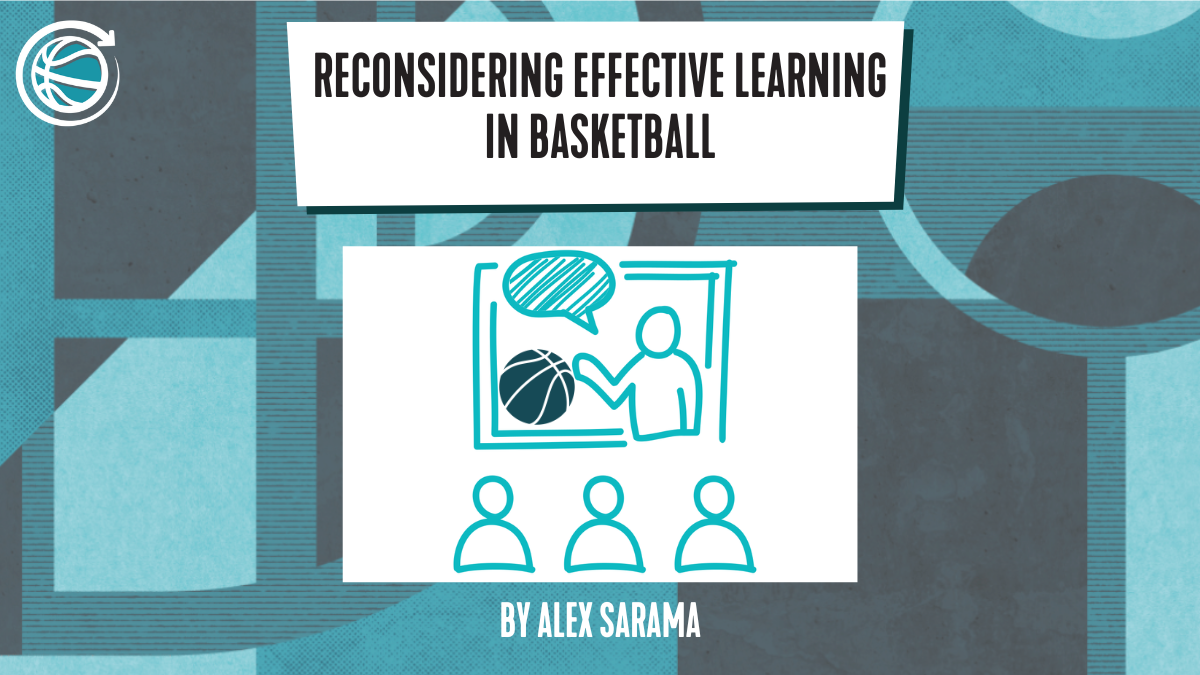Reconsidering Effective Learning in Basketball
August 26, 2024
“Learning is characterised by a search for functional performance solutions, where the learner is challenged beyond mere repetition and imitation of a putative classic action” – Nonlinear Pedagogy in Skill Acquisition by Chow et al.,
We believe that as a basketball community, we need to reconsider what learning actually entails. Regardless of whether working with beginners or professional coaches, there are huge misconceptions as to what learning is. This quote from Chow et al., serves as a great introduction for today’s podcast, as well as the following…
“Learning is not the process of repeating one solution, but repeating the process of constantly finding a new solution.” – Ed Coughlan
Within the highly specific context of a pick and roll possession in basketball, it is apparent that every single pick and roll possession is unique. We can never predict exactly what may happen. And yet so frequently, practice tasks fail to prepare players adequately for the complexity of what may happen in such a possession. Highly predetermined actions, where the players know what the coverage will be and what the solution is, are not representative of a sport like basketball. Players do not have the luxury of planning and choosing a movement solution, so why do we still practice like this?!
https://twitter.com/AlexJSarama/status/1630562375769243649?s=20
This video is a good example of how we can use an ecological approach to developing pick and roll offense (and defense). The traditional approach would be to break the various pick and roll actions down into isolated components, such as 2-on-0 practice. The whole essence of pick and roll is an interaction. That is, an interaction between the handler, picker, other teammates and defenders. Shared and nested affordances present themselves during every part of a pick and roll possession. Therefore, when players cannot meaningfully interact with such variables, how can we develop skills in a pick and roll?
Many of the behaviours observed in the video above would not typically be associated with high-school aged players. This video comes from the 2021-22 season with my College Prep team in Italy. The players were between 16 and 19 years old. One of the biggest limitations of traditional coaching styles is that coaches do not believe their players are capable of achieving success within complex environments. This naturally leads to a “fundamentals first” mentality. By insisting that players perform techniques in a vacuum, even at younger ages, it merely delays players from being able to express themselves in a manner seen in this video.
Developing fundamentals such as pivots and chest passes simply has zero connection to what we see in the game itself. To be successful in 5-on-5, we should be striving to develop players who are adaptive and perceptually attuned to their environment. This means that players are able to pick up specifying information such as defensive coverages, positioning of off-ball teammates and defenders, flight of the ball, space available to play in etc. In a pick and roll, this could involve the picker attuning to key advantage creating opportunities such as pick angles, slip outs, ghosts, deep seals etc. For the handler, this could include rejects or bingos, quick drive arounds, splits, skip passes etc. And finally for off-ball teammates, opportunities to find windows or cut.
In order for players to become adept at demonstrating a variety of functional solutions within these scenarios against multiple types of pick and roll defenses, coaches can use the principles of representative design to create small slices of the game in practice. Through using small-sided games with appropriate task constraints, players can flourish and come up with solutions that you might not even be expecting as the coach!
When doing this, the behaviours that emerge within the activity itself may naturally reveal what direction to go in next. For instance, help defenders may be late to tag as a result of the rollers being so proficient at getting underneath the defense. This then provides information to the coaching staff as to what needs to be improved defensively, allowing them to design an activity or constraint that targets this rate limiter. It’s not a case of using a games approach and simply hoping that playing the small-sided game will allow for everything to take care of itself! What this looks like in my practices, is often a period of intense observation. I observe what is emerging, and then tweak the constraints in response to this.
Ultimately, learning is far more complex than a linearised outlook of “more reps, more improvement.” While this attitude is still the dominant one within basketball, times are rapidly changing. The organisations who serve to gain the greatest advantages are therefore the ones that understand the nonlinear nature of learning, while designing processes which complement this contemporary perspective.
Learn more about nonlinear pedagogy:

Leave a Reply Cancel reply
Community Ideas
CATEGORY
browse by
Skill Acquisition
Practical Ideas
Principles of Play
News
The Theory
Author
browse by
Adam Omiecinski
Alex Sarama
Kareem Kalil
Jonas de Bruyne
CATEGORY
News
browse by
The Theory
Community Ideas
Skill Acquisition
Practical Ideas
Principles of Play
Adam Omiecinski
Alex Sarama
Kareem Kalil
Jonas de Bruyne
Author
browse by